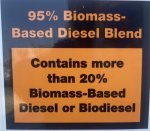Chainbreaker
Well-known member
- 1,820
- 2,080
- 113
- Location
- Oregon
Anybody following the HVO (aka: Renewable Diesel) situation? I was not aware of it until I recently stumbled across a couple of articles on it by accident:
What is the difference between renewable diesel and traditional biodiesel - if any? | Neste
Audi's V6 Diesel Engines Can Now Run On Renewable Fuels | The Drive
I like the 30% higher Cetane rating they allege!
Of course, the real ? is what will it cost, as compared to conventional Biodiesel blends B5-B20. Since its 100% non-dino based diesel is it going to cost less or more?
Sounds promising... but time & cost will tell if its a successful dino/blend diesel replacement fuel.
What is the difference between renewable diesel and traditional biodiesel - if any? | Neste
Audi's V6 Diesel Engines Can Now Run On Renewable Fuels | The Drive
I like the 30% higher Cetane rating they allege!
Of course, the real ? is what will it cost, as compared to conventional Biodiesel blends B5-B20. Since its 100% non-dino based diesel is it going to cost less or more?
Sounds promising... but time & cost will tell if its a successful dino/blend diesel replacement fuel.





